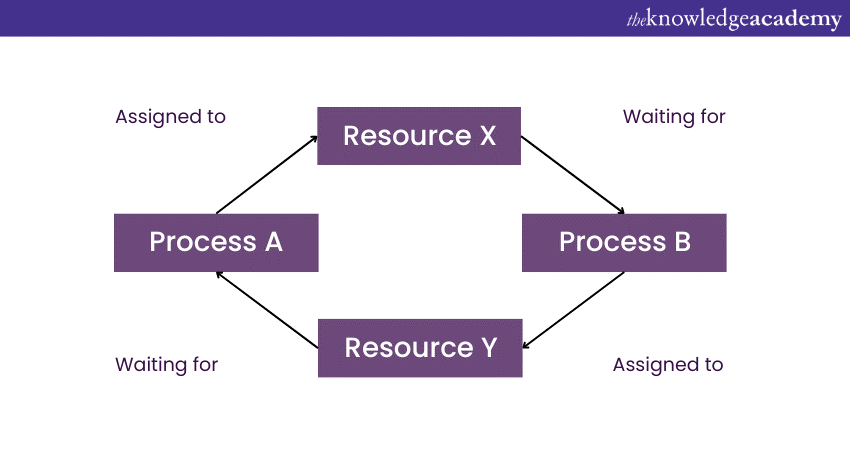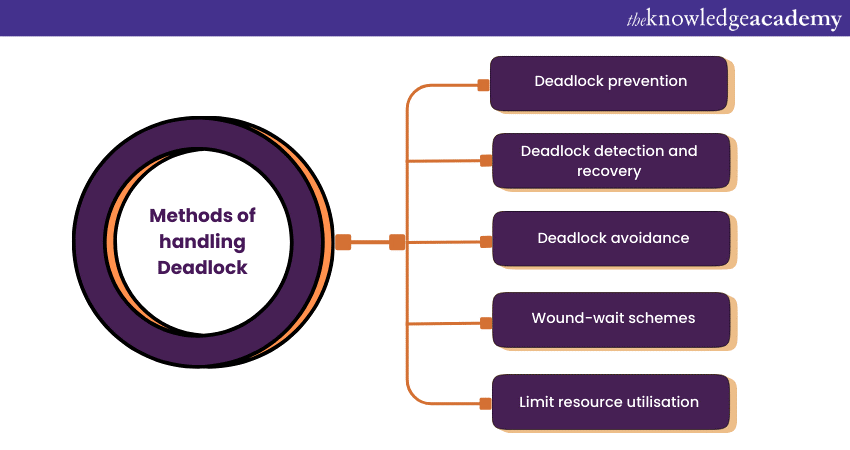We may not have the course you’re looking for. If you enquire or give us a call on 01344203999 and speak to our training experts, we may still be able to help with your training requirements.
Training Outcomes Within Your Budget!
We ensure quality, budget-alignment, and timely delivery by our expert instructors.

In any system, every process needs to utilise resources to be implemented. These resources could take the form of plugged-in devices like standard input and output devices or a system's CPU. Once a process finishes, the resource being used is released. However, when multiple processes occur simultaneously, they may compete for resources, leading to a Deadlock in the Operating System (OS). Tech experts have identified this situation of Deadlock in OS as a common issue.
Deadlock in Operating System happens when two or more processes cannot complete their execution because each is waiting for a resource held by the other. In this blog, we will delve into what Deadlock is, with detailed examples to help you understand it better. We will also cover various methods for handling Deadlock.
Table of contents
1) Understanding Deadlock in OS
2) Necessary conditions for Deadlock
3) Example of Deadlock in OS
4) Methods of Handling Deadlock
5) Benefits of the Deadlock Method
6) Limitations of the Deadlock Method
7) Differences between Deadlock and Starvation
8) Conclusion
Understanding Deadlock in OS
Deadlock in OS refers to a situation where more than one or two processes or threads are not able to proceed because each is waiting for the other to release a resource. In other words, it’s a state where a group of processes become stuck in a way that they can’t make any progress. Deadlock usually occurs in systems where multiple processes compete for limited resources such as CPU time, memory or input or output devices.
If you want to learn how to build iOS applications and debug apps, check out our IOS App Development Training now!
Necessary conditions for Deadlock
There are four necessary conditions for a Deadlock to occur, often referred to as Deadlock conditions. Here are the following essential conditions for Deadlock:
1) Mutual exclusion: In this condition, only one method must be non-shareable. It means only one process can use it at a time. This condition ensures that a resource cannot be simultaneously accessed or modified by multiple processes.
2) Hold and wait: The process must hold at least one resource while waiting to acquire additional resources. This condition can lead to a situation where processes hold some resources and wait indefinitely for others.
3) No pre-emption: Resources cannot be pre-empted or forcibly taken away from a process. This means that a resource can only be released voluntarily by the process holding it. If a process is holding a resource and cannot complete its task due to waiting for another resource, it will not release its current resource, contributing to a potential Deadlock.
4) Circular wait: There must be a circular chain of one or more processes, each of which is waiting for a resource held by another process in the chain. This circular waiting pattern means that no process in the cycle can make progress because another process blocks it.
Example of Deadlock in OS
Here's a simple example of a Deadlock involving two processes, Process A and Process B, competing for two resources, Resource X and Resource Y:

Initial stage
Initial State
1) Process A holds Resource X and requests Resource Y
2) Process B holds Resource Y and requests Resource X
Execution Sequence
1) Process A starts and acquires Resource X
2) Process B starts and acquires Resource Y
Stalemate
1) Process A requires Resource Y to complete its task, but it can’t proceed because Process B is holding it.
2) Process B requires Resource X to complete its task but can’t proceed because Process A is holding it.
Neither Process A nor Process B can release their held resource because they are still waiting for another resource to be released. This circular waiting condition fulfils one of the necessary conditions for Deadlock, leading to a Deadlock situation.
Get familiar with Android Architecture with our Android App Development Training now!
Methods of Handling Deadlock
The following are the methods of handling Deadlocks.

1) Deadlock prevention: Deadlock prevention strategies aim to eliminate one or more of the necessary conditions for Deadlock. This approach ensures that Deadlock cannot occur in the system. One common method involves resource allocation graphs or resource allocation policies to track and manage resource allocation.
2) Deadlock detection and recovery: Deadlock detection is a process of periodically checking the system for the existing Deadlocks. Once the Deadlock is detected, the system can take action to resolve it. Detection and recovery are reactive approaches to managing Deadlocks after they occur.
3) Deadlock avoidance: Deadlock avoidance uses resource allocation algorithms and request protocols to dynamically allocate resources in a way that prevents the system from entering a Deadlock state. The key is to make sure that resource requests do not lead to situations where all necessary conditions for Deadlock are met.
4) Wound-wait schemes: Wound-wait scheme handles Deadlock situations in the Data Management system, allowing either older transactions to wait or younger transactions to wait and deciding which one should be aborted based on their age.
5) Limit resource utilisation: This method involves limiting the huge number of resources that can be allocated to a process. By restricting resource usage, the system reduces the likelihood of Deadlock occurrence. However, this approach may impact system efficiency and resource utilisation, so it should be used judiciously.
Benefits of Deadlock Method
The following are the benefits of the Deadlock method:
1) Proactive approach: The Deadlock Method ensure that Deadlock cannot occur by eliminating one or more necessary conditions.
2) Resource reclamation: The recovery method can potentially free up resources, allowing another process to continue execution. This can minimise the impact of Deadlock on system performance.
3) Risk reduction: By restricting the maximum number of resources that can be allocated to the process, this method reduces the risk of Deadlock. It provides a very easy way to make sure that processes do not consume an excessive number of resources.
4) Resource guarantees: It can provide resource guarantees to critical processes and ensure that certain resources remain available for essential tasks.
5) Detection and resolution: Deadlock detection and recovery methods allow systems to detect and resolve Deadlocks when they do occur. This capability ensures that the system can continue functioning even in Deadlocks, improving system robustness.
Limitations of Deadlock Method
Here are some of the limitations of the Deadlock Method:
1) Complexity and overhead: Many deadlock handling methods add complexity to the system. Implementing and maintaining these methods can be resource-intensive.
2) Process interruption: Deadlock resolution methods such as process termination can hinder the process of the execution or transaction. This disruption can disrupt critical tasks and ultimately lead to inconsistency.
3) Complex decision-making: The Deadlock Handling Method involves complex decision-making to determine which process to abort or wait for. This decision makes the handling of Deadlock more intricate.
4) Performance impact: The mechanisms used for Deadlock handling can introduce performance overhead. For example, frequent Deadlock deduction and recovery processes can affect the CPU cycle and system resources.
5) Increased latency: In some cases, deadlock handling methods can introduce latency into system operations. This latency can impact real-time or time-sensitive applications where responsiveness is critical.
Unlock your web design potential: Join our Website Design Course today!
Differences between Deadlock and Starvation
There is often confusion between deadlocks and starvation in operating systems. However, these two concepts are actually quite different. Deadlocks occur when two or more processes are blocked, waiting for each other to release resources. In contrast, starvation occurs when a process is unable to access resources due to competition from other processes.
|
Basis |
Deadlock |
Starvation |
|
Definition |
Deadlock refers to a situation where two or more processes or threads are unable to proceed because each is waiting for another resource. |
Starvation occurs when a process or thread is unable to access a resource it needs to execute its task despite continuous attempts to do so. |
|
Cause |
Deadlocks occur due to conflicts over resource allocation and synchronisation. |
Starvation can occur due to resource allocation policies or scheduling algorithms that favor some processes over others. |
|
Resolution |
It can be resolved by various methods, such as process termination, resource pre-emption, or process rollback and re-execution. |
Starvation is typically addressed by improving scheduling algorithms or resource allocation policies. |
|
Ways to handle |
Deadlock can be handled by neglecting any four situations. |
Starvation can be handled through aging. |
|
Other names |
It is also known as a circular wait. |
It is also known as a lived lock. |
Conclusion
This is all about Deadlock in the Operating System. In this blog, we have discussed what Deadlock in OS is, examples to understand Deadlock more clearly, methods of handling Deadlock, benefits and limitations of the Deadlock Method and the difference between Deadlock and Starvation in OS.
Check out our App & Web Development Training now!







 Top Rated Course
Top Rated Course




 If you wish to make any changes to your course, please
If you wish to make any changes to your course, please


